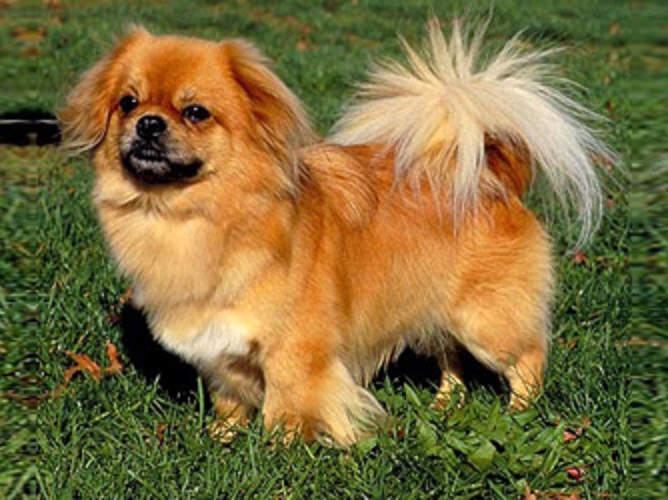
Tibetan Spaniel

Navigate through the tabs
Navigate through the tabs below to view the breed's info of your interest.
The breed's info is divided in four sections; namely:
the breed's history ,
the breed's main stats ,
the dog's potential health issues
and finally, how the breed scored in 26 different categories.
All the above information should give you a respectively good overview for the dog of your interest.
Dog Breed's Main Info
The Breed's History:
The Tibetan Spaniel is an ancient breed from Asia. Depictions of small dogs with pushed-in faces and lionlike coats date back centuries in China and Tibet.
It's believed that Buddhist monks, known as lamas, bred the little dogs to sound the alarm if anyone approached the lamasery. With the ruff of thick fur around their neck and the richly plumed tail, they were said to resemble little lions. In Buddhist symbology, lions represent Buddha's triumph over violence and aggression, so dogs with a lionlike appearance were popular.
The dogs were frequently given as gifts to ambassadors and other notables, with dogs from those countries being received in return. Thus the Tibetan dogs made their way to the courts of China and Japan, where they no doubt interbred with other small Asian dogs. Today's Tibetan Spaniel probably shares a common ancestry with the Japanese Chin and the Pekingese.
Often bred by Tibetan villagers as well as lamas, early dogs of this type came in a wide range of sizes. The smallest, most prized puppies were given to the lamaseries where they were probably bred with the more elegant dogs that arrived as gifts from China.
During the late 19th century, the first Tibetan Spaniel was brought to England by Mrs. McLaren Morris. More arrived in the 1920s, courtesy of Dr. Agnes R. H. Greig, who sent some of the dogs to her mother. The breed gained some popularity, but its foothold in England was almost completely wiped out during World War II.
In 1947, after several successful breedings and importations, the breed began to recover in England. In 1958, The Tibetan Spaniel Association was formed and in 1960 England's Kennel Club recognized the breed.
The first known litter in the United States was born in 1965, to parents imported from Tibet by a Mr. Harrington. Thanks to Leo Kearns, sexton of Trinity Lutheran Church in New Haven, Connecticut, the Tibetan Spaniel began attracting notice. Kearns had a Tibbie puppy, and his parishioners were quite taken with her. He imported a male, and the puppies the two dogs produced were soon placed in doting homes.
Among those enthusiastic new owners was Mrs. Jay Child, who made it her mission to see the breed established in the U. S. The Tibetan Spaniel Club of America was founded in 1971, with Child as president. The American Kennel Club recognized the breed in 1984.
Despite his charm, the Tibetan Spaniel is still pretty rare, ranking 101st in popularity among the breeds and varieties registered by the American Kennel Club.
Country of Origin:
Tibet
Breed Group:
Companion
Height:
10 inches to 11 inches (25,4 to 27,94 cm)
Weight:
9 to 15 pounds (4,08 to 6,81 Kg)
Life Span:
12 to 15 years
Potential Health Issues:
Patellar Luxation,
Allergies,
Cherry Eye,
Progressive Retinal Atrophy (PRA),
Weeping Eye
Adaptability
Apartment Living:
First Time Owners:
Sensitivity:
Being Alone:
Cold Weather:
Hot Weather:
Friendliness
Affection With Family:
With Kids:
With Dogs:
With Strangers:
Health and Grooming
Shedding:
Drooling:
Easy To Groom:
Overall Health:
Weight Gain Potential:
Size:
Training
Easiness:
Intelligence:
Mouthiness:
Prey Drive:
Barking or Howling:
Wanderlust:
Need For Exercise
Energy Level:
Intensity:
Exercise Needs:
Playfulness:
Our Mobile Application
Check out Our Mobile Application "Dog Breeds Central"
